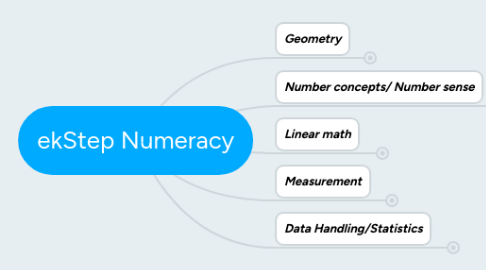
1. Geometry
1.1. Spatial relations vocabulary
1.1.1. Development of vocabulary - Same, different, Top, Bottom, On, Under, Inside, Outside, Above, big, small, Below, Near, Far, Before, After, thick, thin, light, heavy, empty, full, less, more, few,many
1.2. 2D Shapes/Patterns
1.2.1. Distinguish & draw lines (Straight, vertical, horizontal)
1.2.2. Recognize and identify colors
1.2.3. Compare shapes: big/more, large/small, same/different, few/many, one to one correspondance
1.2.4. Arrange/order in shapes
1.2.5. Identify, classify, draw different Angles : acute, obtuse, and right angles; Understand by folding paper
1.2.6. Observe, Identify, Draw 2D shapes
1.2.7. Explores intuitively rotations and reflections of familiar 2-D shapes.
1.2.8. Properties of 2D shapes: understand triangle is 3 sides etc.
1.2.9. Understand concept of area and perimeter
1.3. 3D Objects
1.3.1. Recognize and identify colors
1.3.2. Observe, Identify, Draw 3D shapes
1.3.3. Arrange/order in objects
1.3.4. Spatial understanding: volume - understand and compare objects, liquids in container
1.3.5. Understand and compare weight of objects
1.3.6. 3D to 2D objects
1.3.7. Properties of 3D shapes
2. Number concepts/ Number sense
2.1. Counting
2.1.1. Sense of quantitites, count objects
2.1.2. Map quantities to numbers
2.1.3. Estimation of quantities without counting
2.1.4. Concepts of counting: stable order, one to one correspondance, cardinality, order irrelevance
2.2. Sequence
2.2.1. Order and compare numbers (Ascending & descending order,skip counting, whole-part relationship, additive reasoning etc.), mental number line
2.3. Place value
2.3.1. Understand tens and ones, higher digit place value, Expansion (expand a number with respect to place values)
3. Linear math
3.1. Addition
3.1.1. Understand symbols
3.1.2. Estimation of sum
3.1.3. Without grouping
3.1.4. Addition as inverse of subtraction
3.1.5. With grouping
3.1.6. Properties: commutative, associative
3.1.7. Mental maths; Single digit, multiples of 10
3.2. Subtraction
3.2.1. Understand symbols
3.2.2. Estimation of difference
3.2.3. Without grouping
3.2.4. Addition as inverse of subtraction
3.2.5. With grouping
3.2.6. Properties: commutative, associative
3.2.7. Mental maths; Single digit, multiples of 10
3.3. Multiplication
3.3.1. Understand meaning of multiplication (as multiple addition, combination of units, etc.)
3.3.2. Multiplication of 2 digits, 3 digits
3.3.3. Multiplication tables upto 10(understand, learn)
3.3.4. Factors and multiples
3.3.5. Mental Maths: Estimate products and verify using approximation; Mental Maths (adding partial products, multiplication in mind)
3.4. Division
3.4.1. Meaning of division in the context of equal grouping and sharing; inverse multiplication; by multiplication tables
3.4.2. Relate division with multiplication
3.4.3. Divide a number with another given number
3.4.4. Factors and multiples
3.4.5. Mental Maths: Estimate quotients and verify using approximation; Mental Maths (adding partial products, multiplication in mind)
3.5. All operations
3.5.1. BODMAS etc.
3.5.2. Solve using money
3.6. Word problem
3.6.1. Understand, interpret and frame word problems
3.7. Fraction
3.7.1. Understand, represent fractions, notations of 1/2, 1/4, 3/4
3.7.2. Compares fractions
4. Measurement
4.1. Length/ weight/ volume
4.1.1. Measurement with non standard metric
4.1.2. Measurement with standard metric
4.1.3. Compare
4.1.4. Estimate
4.2. Time
4.2.1. Measuring and reading time and calender
4.3. Measurement of geometry/shapes
4.3.1. Understanding the concept of area/perimeter
4.3.2. Measurement of 2D shapes
4.3.3. Measure, estimate and compare volume for 3D shapes
4.4. Angles
4.4.1. Learn to represent angles numerically
5. Data Handling/Statistics
5.1. Collect data
5.1.1. Collect and represent data
5.2. Data interpretation
5.2.1. Draw inferences from data
5.3. Graphical representation
5.3.1. Collect and represent data : Pictograph, Bar graph, Tables, Tally marks
5.4. Money conversion
5.4.1. Identify money, handle small amounts of money
5.4.2. Conversion of denominations, add and subtract using small amounts of money

